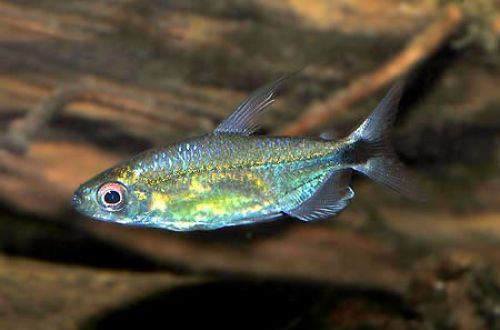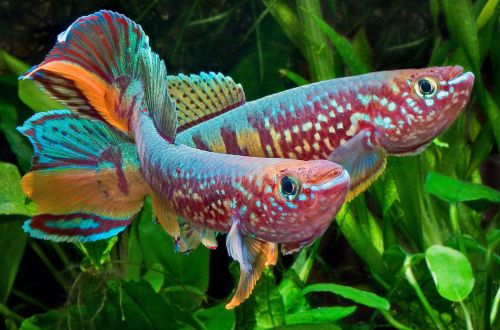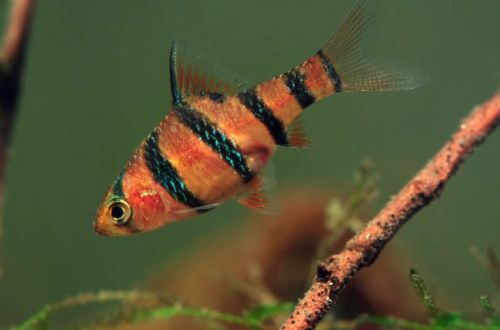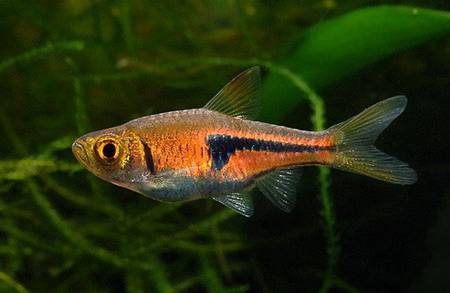
Blue Tetra
Coelurichthys small-scaled or Blue Tetra, scientific name Mimagoniates microlepis, belongs to the Characidae family. A beautiful schooling fish that can “speak”, or rather make sounds to attract a partner during the mating season. To enhance the effect, males use pheromones produced by special glands at the base of the tail. Due to its unpretentiousness in maintenance and compatibility with many other species, it can be recommended to beginner aquarists.

Contents
Habitat
Widespread fish on the South American continent. Occurs from the territory of the southeastern states of Brazil from part of Bahia to Rio Grande do Sul. Inhabits numerous rivers and their tributaries, coastal and river floodplains.
Brief information:
- The volume of the aquarium – from 70 liters.
- Temperature – 18-23°C
- Value pH — 6.0–7.0
- Water hardness – soft to hard (2-20 dGH)
- Substrate type – any
- Lighting – subdued / moderate
- Brackish water – no
- Water Movement – Low/Moderate
- The size of the fish is up to 6 cm.
- Meals – any
- Temperament – peaceful
- Keeping in a flock of at least 8-10 individuals
Description
Adults reach a length of about 6 cm, in the aquarium a little less. They have a pale blue color, in males it is more intense, in addition, they have more elongated fins than females. During the mating season, males use special pheromones to attract female representatives, and are also able to make “croaking” sounds with the help of a swim bladder.
Food
In an aquarium, it will accept all types of dry, frozen and live food. Their quality and composition largely affect the color of the fish, so strive to purchase food only from well-known and reputable manufacturers.
Maintenance and care, arrangement of the aquarium
For a small flock of Blue Tetras, a tank of 70 liters or more is required. The design uses a dark substrate, various shelters in the form of snags or decorative elements (wrecks, castles, etc.), dense thickets of plants, including those floating on the surface. Plants are placed in certain areas to prevent overgrowth of the aquarium and save free areas for swimming.
It is possible to bring the conditions of keeping closer to those characteristic of the natural habitat with the help of a small amount of natural “garbage” that will freely roll along the bottom, for example, short twigs, sticks and the placement of a low power artificial current system. Such a system is installed in such a way that the water flows are not directed parallel to the surface, but at an angle to it. This creates ripples, a slight turbulence. During feeding, it is recommended to turn it off so as not to spread the food throughout the volume.
Water conditions have a pH close to neutral and wide tolerances for hardness. Acceptable temperature is low enough and should not exceed 23°C. Maintenance and care is typical of most tropical aquariums.
Behavior and Compatibility
Peaceful schooling fish, able to get along with any other species of similar size and temperament, able to live in similar conditions (moderate current and low temperatures). Avoid sharing overly active and even more aggressive neighbors.
Breeding / breeding
The appearance of fry is possible even in a common aquarium, but their number will be very small and will decrease every day if they are not transplanted into a separate tank in time. It’s all the fault of adult fish, for which fry are a great addition to the diet.
In order to increase the chances of survival and somehow systematize the breeding process (spawning was not spontaneous), it is recommended to use a spawning aquarium, where sexually mature fish are placed during the mating season. Usually this is a small container with a volume of about 20 liters. The design is arbitrary, the main emphasis is on the substrate. In order to protect the eggs from being eaten (Blue Tetras eat their own offspring), the bottom is covered with a fine-mesh net, or with small-leaved plants or mosses (for example, Java moss). An alternative way is to place a layer of glass beads with a diameter of at least 1 cm. The lighting is subdued, a heater and a simple airlift filter are sufficient from the equipment.
The stimulus for the beginning of the mating season is a gradual change in the water parameters in the common aquarium to the following values: pH 5.5–6.5, dH 2–8 at a temperature of about 22–23°C. The basis of the diet should be frozen or live food.
Carefully observe the fish, soon some of them will noticeably round up – these will be females swollen from caviar. Males will begin to make sounds similar to croaking – this is a feature of this species and show signs of attention to their chosen ones. Prepare and fill the spawning tank with water from the community tank. Put the females there, the next day a couple of large males that look the most striking.
It remains to wait until spawning occurs, its end can be determined by females, they will “lose weight” greatly, and eggs will be noticeable among the vegetation (under a fine mesh).
The fish are returned. The fry will appear within 48-72 hours, after another couple of days they will begin to swim freely in search of food. Feed with specialized microfeed.
Fish diseases
A balanced aquarium biosystem with suitable conditions is the best guarantee against the occurrence of any diseases, therefore, if the fish has changed behavior, color, unusual spots and other symptoms appear, first check the water parameters, and only then proceed to treatment.





